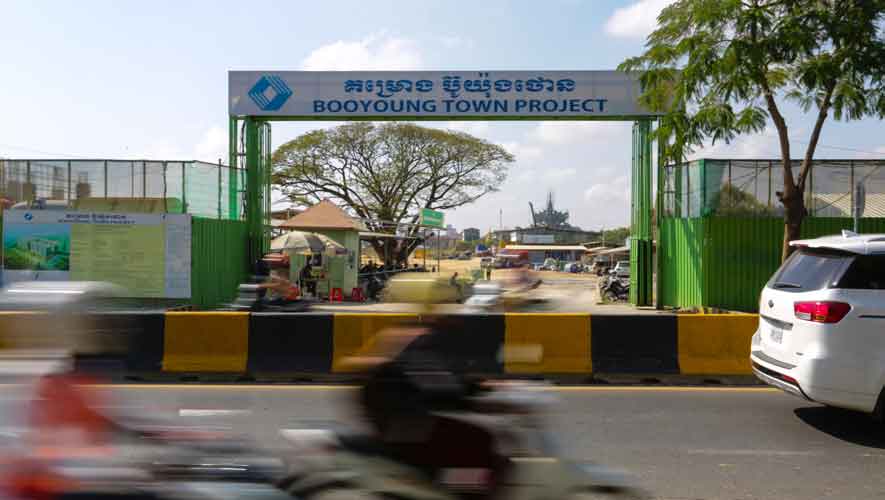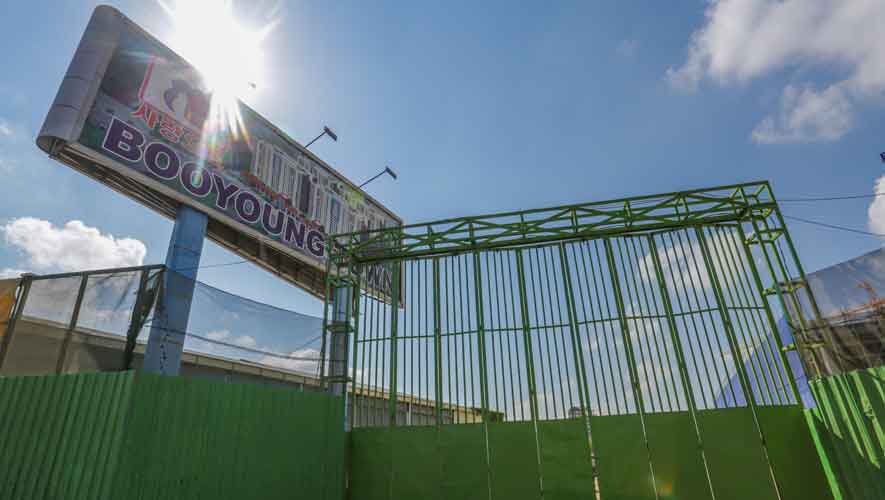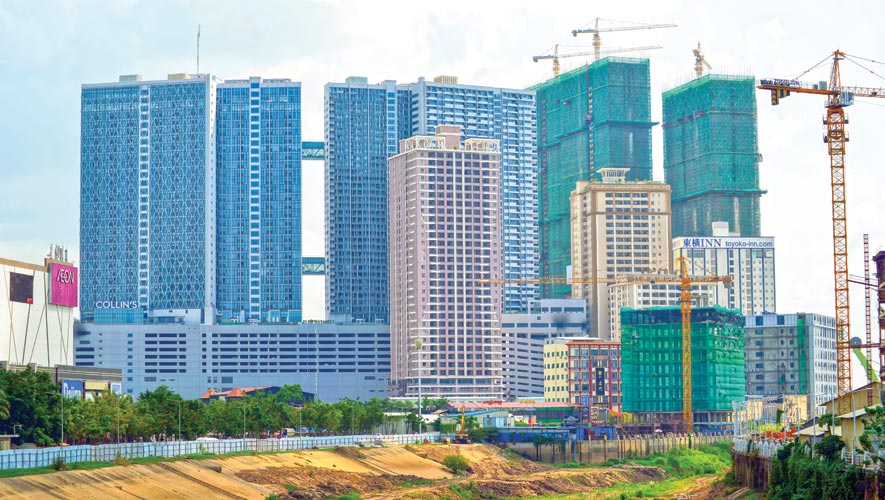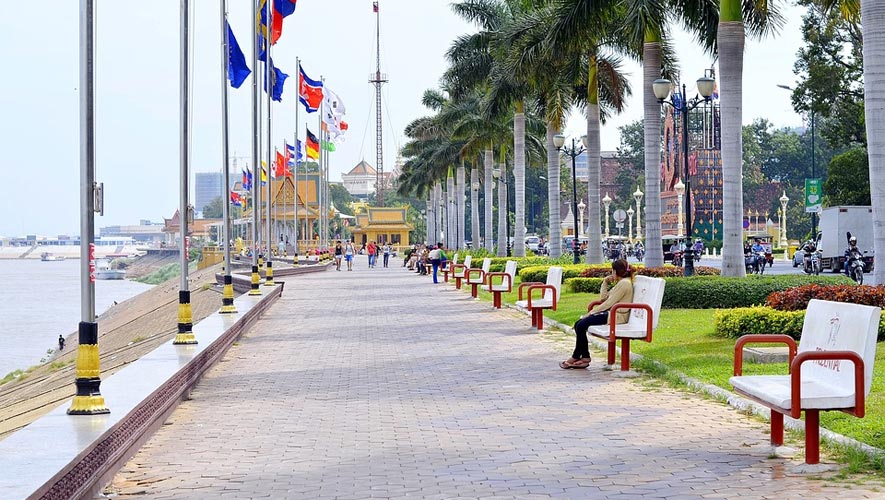The Koreans once dominated the real estate headlines with billion dollar projects. Financial scandals almost saw them packing their bags out of town. Can they make a come back?
For the latest Cambodian Business news, visit Khmer Times Business
The Booyoung Town development represents the waning influence of the Koreans and their lasting legacy etched into the fabric of the city. There was a time when Korean developers were seen as trailblazers and their ambitions dominated the Kingdom’s real estate headlines.
Today, Booyoung Town with a gross development value of $1.1 billion appears to have gained some momentum developing its retail podium that will serve as the foundation for its massive condominium towers that line the western portion of Russian Boulevard in Phnom Penh.
The renewed construction is part of the first phase of 10 planned for the project that broke ground in May 2013, only to suffer several lapses over the years.
It became a habitual eye-sore inhabiting 2.7 square kilometres in Tek Thla within the Sen Sok district along the road to Phnom Penh International Airport, and seemed to be just another stalled Korean project among many dating back to the 2000s.
“Korean developers and investors have been active in Cambodia for decades and that affiliation continues, albeit they now share the market with an increasingly diverse and deep pool of competitors,” says James Hodge, associate director of CBRE Cambodia.
The Koreans’ first earnest forays began before the 2008 financial crisis.
“Korean developers were some of the first movers in Cambodia,” Hodge tells Capital Cambodia.
“During this period, some Korean investors were able to build up significant land banks. However, domestic problems post-crisis created a lull in activity for some,” he adds.
Problems at home continue to haunt Korean projects, and Booyoung Town is no exception. Booyoung Group, the real estate developer and 16th largest conglomerate in South Korea, saw its chairman Lee Joong-keun punished for financial crimes last year.
The real estate media in the Kingdom loves a revival story as much as it loves a scandal. And perhaps by speeding up construction, Booyoung Group hopes to steer clear of scandal winds that may impact the project.
An administrative staff at Booyoung Town, who declined being named, made it clear the project heads were not keen to comment on the legal issues surrounding Lee, emphasising that the scandals had no “effect on our project”.
The group however, plans to complete “50 to 70 percent of the structures (of phase one) before selling”. The visibility of the structures is pertinent to the sale.
“We want to speed up the construction. Many (potential) customers are enquiring about the price and when we would start selling (the units) but due to our company policy we are not allowed to sell yet. We want to (first) showcase the company’s capability to the customers,” the staff tells Capital Cambodia.
In February 2018, South Korean Yonhap news agency reported that the Seoul Central District Prosecutors’ Office filed an arrest warrant for Lee on charges of tax evasion, embezzlement and breach of trust. Law enforcement officials also investigated if he secretly transferred a slush fund worth $250 million to a bank account in Cambodia.
Last November, Lee was sentenced to five years in prison for embezzlement and breach of trust, and ordered to pay a fine of $88,260.
Factbox
Original estimated cost of Booyoung Town commercial city and housing estate project: $1.1 billion
Original estimated cost of Camko City satellite city project: $2 billion
Original estimated cost of Gold Tower 42: $420 million
Project start date for Booyoung Town: 2013
Project start date for CamKo: 2007
Project start date for Gold Tower 42: 2008
Booyoung Town’s first phase includes four condominiums rising 23 floors, not including the basement and the parking lot. The project is estimated to have nearly 1,474 active units. The phase of the project also includes a three-storey shopping mall, with a capacity of 47,000 square metres. The shopping mall includes commercial centres, cultural centres, hospitals, schools, entertainment facilities and beauty shops.
This is not the first time South Koreans were investigated for their alleged involvement in illegal activities tied to projects in Cambodia. In 2011, reports came out that South Korean authorities were investigating Busan Mutual Savings Bank, which partnered with CamKo City’s developer World City Co Ltd, for raising slush funds by offering illegal construction project loans that included CamKo.

Lofty ambitions
The story dates back to 2004 when Camko City’s development team arrived in Phnom Penh to survey an area with dirt roads, rubble, shanty towns, squatters, wild dogs and open sewage.
They were like modern day pioneers with plans out of a coloniser’s dengue-infected fever dream - to relocate the heart of the city to the capital’s northern flank, Tuol Kok.
“What we were planning (in 2004) was to relocate the centre of Phnom Penh because at the time there were no facilities which a capital city must have in order to thrive,” K.C. Whang, former vice-president of World City, said in 2015 when the company started emerging out of its five-year purgatory of inactivity and lawsuits.
“That’s why when you see our master plan, the residential area is small [in context] and we have a big commercial area with a financial district,” he had said then.
Phnom Penh in the late aughts was still untamed and some corners of the capital could be described as desolate, so one could imagine the attention the announcement of the utopian-sounding “first Global City in Phnom Penh” garnered when it broke ground in 2007.
The multi-billion dollar South Korean satellite city project, 1.2-square kilometers at that, included residential units, a financial centre, government offices, a convention centre, shopping centres, universities, and a medical centre.
In 2010, the development froze as the 2008 global financial crisis brought down World City’s banking partner Busan Savings Bank, and its contractor Hanil Engineering & Construction Co subsequently came under court receivership. All construction work was halted until arbitration proceedings with Hanil was completed.
Fast forward to now, CamKo seems to have weathered its rough patch with new funding sources and local contractors.
“CamKo is doing well now,” says Chrek Soknim, chief executive officer of Century 21 Mekong.
But the scars accrued from the toll of the financial crisis left its indelible mark and the once shiny, utopian projects now appear dated and worn next to new projects like Borey Peng Hout, Borey Chip Mong, Borey Vimean Phnom Penh and Borey Lim Cheang Hak. “The buildings are standard,” Chrek says.
Chinese big fish crowding pond
A big fish in a small pond then, the Koreans now find themselves overtaken by bigger, richer, and faster projects helmed by the Chinese and Taiwanese. The new 2.0 overseas companies are also better researched and organised. They have emerged as leading overseas developers with Taiwanese players on top based on project volume while mainland Chinese lead in terms of investment value due to the size of developments.
“(Although) in recent years we have seen a resurgence of Korean developers in the market, they come at a time when overall activity is at a greater volume and therefore don’t make as large an impact as before,” says Hodge.
"Projects like Booyoung Town, Camko City and Yon Woo Cambodia Co Ltd’s Gold Tower 42 are all substantial developments but now other groups, particularly Chinese and Singaporean developers are starting to deliver projects of equal, if not larger scale." CapCam
Donald Jae Lee
Business Writer, Capital Cambodia




